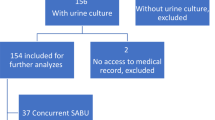Abstract
The aims of the study presented here were to identify the risk factors associated with bacteremia in a long-term-care facility and to evaluate the role of blood cultures in the management of elderly patients with sepsis. All blood cultures performed during a 2-year period (3,177 from 1,588 patients) were screened, and 252 (15.8%) of them grew a pathogen. The first 100 bacteremic patients identified were enrolled in the study together with a control group of 100 non-bacteremic patients matched by sex, age and functional status. Chronic renal failure, urinary tract infection, severe sepsis, leukocytosis, eosinopenia and thrombocytopenia were identified as risk factors associated with bacteremia. Five bacteremic patients died during the first 48 h following the onset of infection, while all of the non-bacteremic patients survived this time period. Of 58 bacteremic patients receiving adequate treatment, 17 patients died, and of 39 receiving inadequate treatment, 12 patients died. These results indicate the usefulness of performing blood cultures in elderly patients with sepsis is questionable.
Similar content being viewed by others
References
Grace CJ, Lieberman J, Pierce K, Littenberg B (2001) Usefulness of blood culture for hospitalized patients who are receiving antibiotic therapy. Clin Infect Dis 32:1651–1655
Chandrakeker PH, Brown WJ (1994) Clinical issues of blood cultures. Arch Intern Med 154:841–849
Peduzzi P, Shatney C, Sheagren J, Sprung C (1992) Predictors of bacteremia and gram-negative bacteremia in patients with sepsis. Veterans Affairs Systemic Sepsis Cooperative Study Group. Arch Intern Med 152:529–535
Bentley DW, Bradley S, High K, Schoenbaum S, Taler G, Yoshikawa TT (2000) Practice guideline for evaluation of fever and infection in long-term care facilities. Clin Infect Dis 31:640–653
Garibaldi RA, Nurse BA (1986) Infections in the elderly. Am J Med 81(Suppl 1A):53–58
MacBean M, Rajamani S (2001) Increasing rates of hospitalization due to septicemia in the US elderly population, 1986–1997. J Infect Dis 183:596
McGowan JE, Barnes MW, Finland M (1975) Bacteremia at Boston City Hospital: occurrence and mortality during 12 selected years (1935–1972), with special reference to hospital-acquired cases. J Infect Dis 132:316–335
Windsor ACM (1983) Bacteraemia in a geriatric unit. Gerontology 29:125–130
Darowski A, Najim Z, Weinberg A, Guz A (1991) The febrile response to mild infections in the elderly hospital inpatients. Age Ageing 20:193–198
Chassagne P, Perol MB, Doucet J, Trivalle C, Menard JF, Manchon ND, Moynot Y, Humbert G, Bourreille J, Bercoff E (1996) Is presentation of bacteremia in the elderly the same as in younger patients. Am J Med 100:65–70
Isselbacher KJ, Braunwald E, Wilson JD, Martin JB, Fauci AS, Kasper DL (eds) (1994) Harrison’s principles of internal medicine, vol. 1. McGraw-Hill, USA p 336
Gil H, Magy N, Mauny F, Dupond JL (2003) Value of eosinopenia in inflammatory disorders: an “old” marker revisited. Rev Med Interne 24:431–435
Toubes E, Singh K, Yin D, Lyu R, Glick N, Russell L, Mohapatra S, Saghal N, Weinstein RA, Trenholme G (2003) Risk factors for antibiotic-resistant infection and treatment outcomes among hospitalized patients transferred from long-term care facilities: does antimicrobial choice make a difference. Clin Infect Dis 36:724–730
Author information
Authors and Affiliations
Corresponding author
Rights and permissions
About this article
Cite this article
Raz, R., Ben-Israel, Y., Gronich, D. et al. Usefulness of blood cultures in the management of febrile patients in long-term care facilities. Eur J Clin Microbiol Infect Dis 24, 745–748 (2005). https://doi.org/10.1007/s10096-005-0046-2
Published:
Issue Date:
DOI: https://doi.org/10.1007/s10096-005-0046-2




